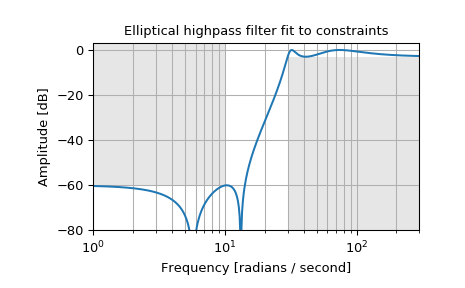scipy.signal.ellipord¶
-
scipy.signal.ellipord(wp, ws, gpass, gstop, analog=False, fs=None)[source]¶ Elliptic (Cauer) filter order selection.
Return the order of the lowest order digital or analog elliptic filter that loses no more than gpass dB in the passband and has at least gstop dB attenuation in the stopband.
Parameters: - wp, ws : float
Passband and stopband edge frequencies.
For digital filters, these are in the same units as fs. By default, fs is 2 half-cycles/sample, so these are normalized from 0 to 1, where 1 is the Nyquist frequency. (wp and ws are thus in half-cycles / sample.) For example:
- Lowpass: wp = 0.2, ws = 0.3
- Highpass: wp = 0.3, ws = 0.2
- Bandpass: wp = [0.2, 0.5], ws = [0.1, 0.6]
- Bandstop: wp = [0.1, 0.6], ws = [0.2, 0.5]
For analog filters, wp and ws are angular frequencies (e.g. rad/s).
- gpass : float
The maximum loss in the passband (dB).
- gstop : float
The minimum attenuation in the stopband (dB).
- analog : bool, optional
When True, return an analog filter, otherwise a digital filter is returned.
- fs : float, optional
The sampling frequency of the digital system.
New in version 1.2.0.
Returns: See also
Examples
Design an analog highpass filter such that the passband is within 3 dB above 30 rad/s, while rejecting -60 dB at 10 rad/s. Plot its frequency response, showing the passband and stopband constraints in gray.
>>> from scipy import signal >>> import matplotlib.pyplot as plt
>>> N, Wn = signal.ellipord(30, 10, 3, 60, True) >>> b, a = signal.ellip(N, 3, 60, Wn, 'high', True) >>> w, h = signal.freqs(b, a, np.logspace(0, 3, 500)) >>> plt.semilogx(w, 20 * np.log10(abs(h))) >>> plt.title('Elliptical highpass filter fit to constraints') >>> plt.xlabel('Frequency [radians / second]') >>> plt.ylabel('Amplitude [dB]') >>> plt.grid(which='both', axis='both') >>> plt.fill([.1, 10, 10, .1], [1e4, 1e4, -60, -60], '0.9', lw=0) # stop >>> plt.fill([30, 30, 1e9, 1e9], [-99, -3, -3, -99], '0.9', lw=0) # pass >>> plt.axis([1, 300, -80, 3]) >>> plt.show()

